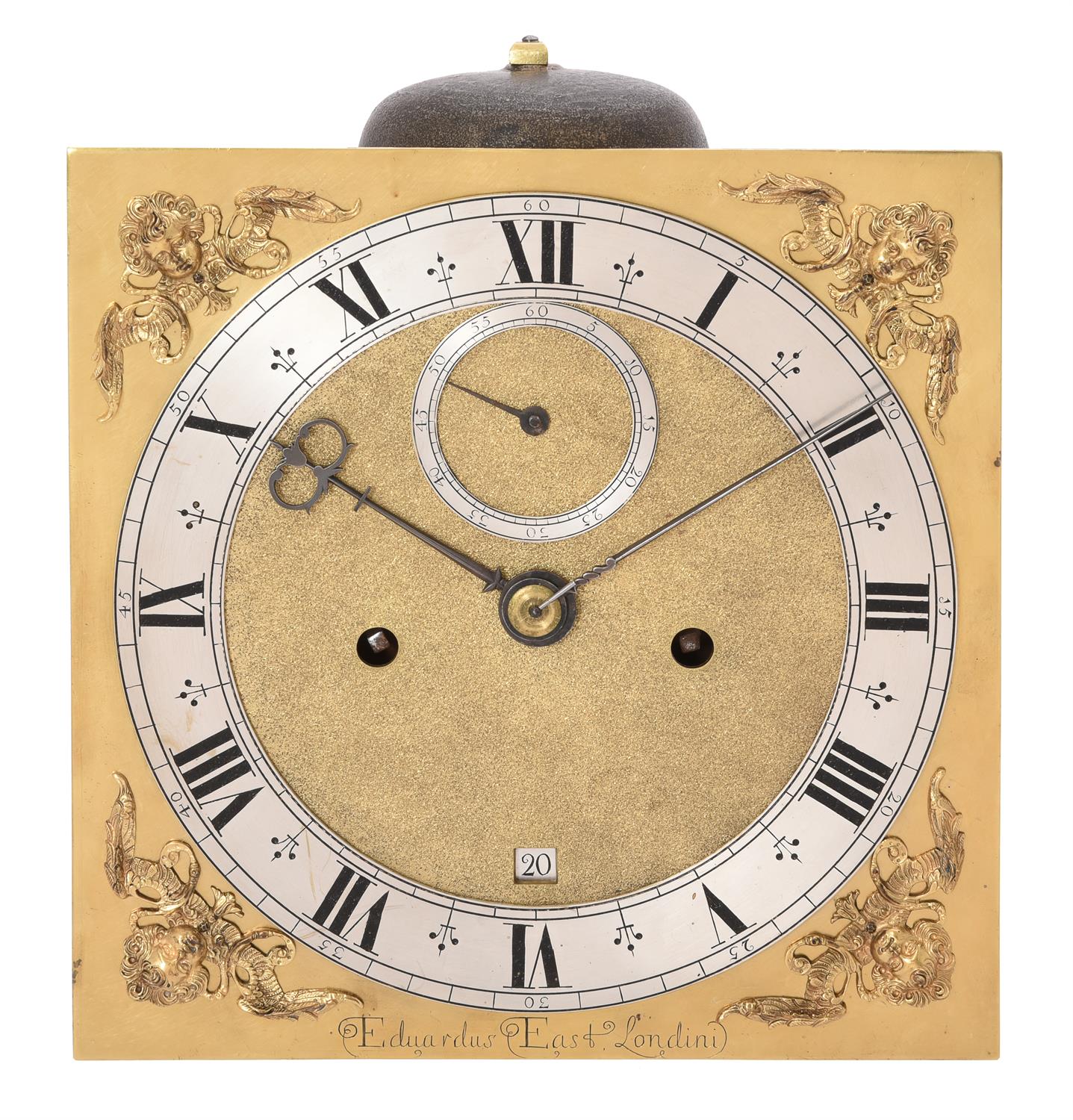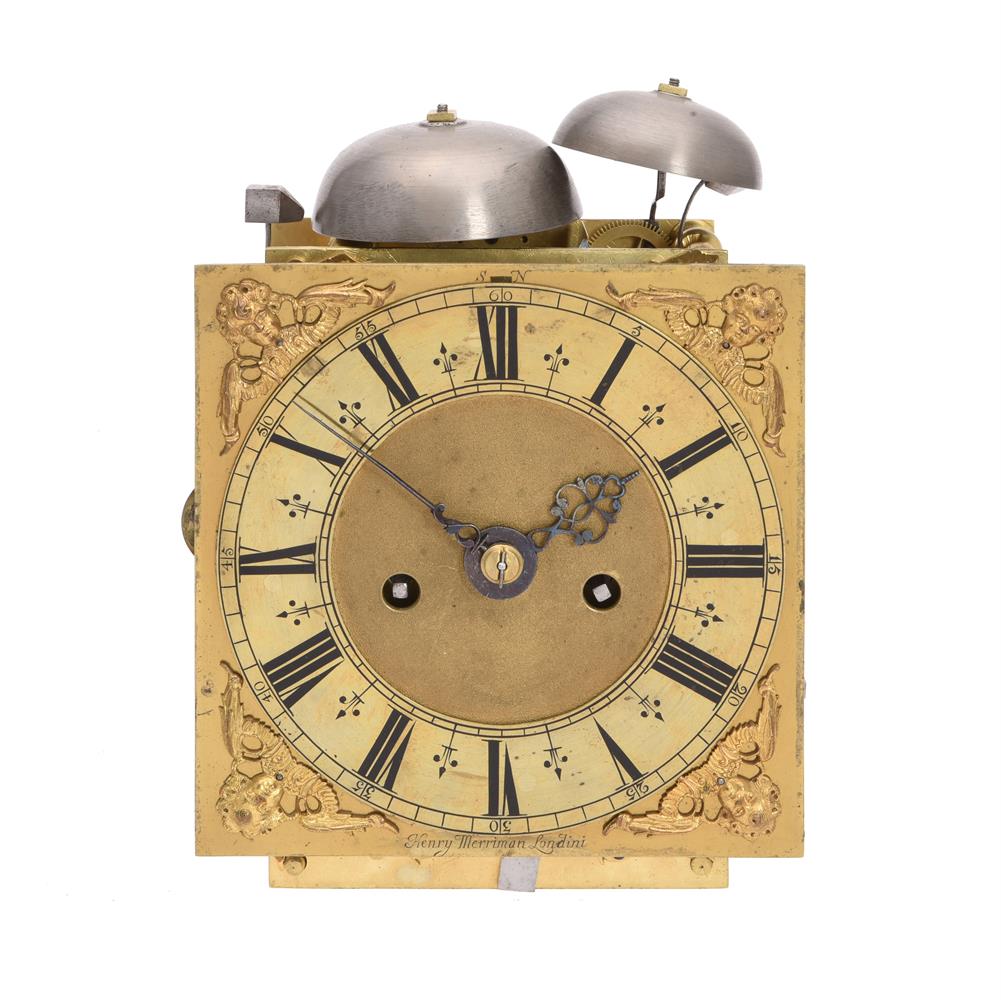A FINE CHARLES II BRASS LANTERN CLOCKJOHN LONDON, BRISTOL, CIRCA 1675-80The posted countwheel bell-striking movement with Huygens's endless chain winding and verge escapement regulated by short bob pendulum swinging outside the frame to the rear incorporating knife-edge suspension, the dial with vacant roundel within stylised symmetrical foliate engraved infill issuing from a large leafy tulip bloom to lower margin and interrupted by engraved signature John London, of Bristoll fecit to the upper, within applied 6 inch narrow Roman numeral chapter ring with stylised fleur-de-lys hour markers, with scroll pierced black steel hand incorporating long tail and engraved radial leaf infill to angles, the typical tall Bristol-type frame with one-piece column turned corner posts beneath lion and unicorn armorial engraved and pierced frets, integral multi-knopped tall vase-and-cover turned finials and domed bell bearer cast with pierced leaf decoration between the limbs, with brass side doors and brass backplate to rear, on tall disc-knopped ball feet.42cm (16.5ins) high, 15cm (6ins) wide, 16.5cm (6.5ins) deep. John London in recorded in Loomes, Brian Clockmakers of Britain 1286-1700 as being a gunsmith working in Bristol by 1675 (references Bellchambers), when he took Robert Sainsbury from Market Lavington as an apprentice. Jim Moore recorded him as being married to Mary Baker in 1678 and he is believed to have still be working in Bristol in 1678. George White in Darken, Jeff (editor) TIME & PLACE, English Country Clocks 1600-1840 illustrates a very closely related clock to the present lot on page 228 (Figure 2.), where it is noted that John London was most likely influenced by leading London-based makers but adopted his own particular style and flair - most noticeable on his surviving longcase clocks. This is most apparent with regards to his engraving which departs from the usual Bristol style, adopting more intense florid designs which are more akin to London work but taken further. White also notes that, as a gunsmith, John London is thought to have engraved his own dials; this was until a lantern clock was discovered with practice engraving beneath the dial together with the name 'Axford'. From this it has been suggested that the engraving may have been executed by someone else, who may have had connections with the brass founder Charles Axford, who is recorded through his marriage in Bristol in 1687. Notwithstanding the above the current lot utilises a variant of the frame castings that were favoured by the Bristol and Chew Valley school of clockmakers, with one of the earliest examples of their use (other than the present clock) being for another example by John London of Bristol illustrated in Loomes, Brian Lantern Clocks & Their Makers on page 179 (Figure 10.41). Loomes dates this clock to the late 1670's whilst another close variant of these castings can be seen on a clock by Edward Webb dated 1676 (private collection), as well as two further examples by the same maker, dated 1682 and 1692 respectively (illustrated in Loomes on page 188, Figures 11.5 - .6). These two variants differ only very slightly in that the feet have 'disc' knops for the John London clock/present lot and 'ball' knops for the Webb clocks. The 'disc feet' castings were also used by other makers such as Edward Bilbie of Chew Stoke (who is believed to have succeeded Edward Webb in around 1695), and both variants were used by Thomas Veale of Chew Magna. Edward Bilbie appears to have persisted with the use of such castings after Bristol makers had mostly moved onto patterns more closely related to London work of the period, suggesting that such frames were continued to be cast locally (possibly through subsequent acquisition of the patterns by the Chew Valley makers). Certainly, from surviving clocks, it would be reasonable to suggest that casting of the frames could have taken place at Edward Webb's foundry in Chew Stoke, then by the Bilbie family after Webb
A FINE CHARLES II BRASS LANTERN CLOCKJOHN LONDON, BRISTOL, CIRCA 1675-80The posted countwheel bell-striking movement with Huygens's endless chain winding and verge escapement regulated by short bob pendulum swinging outside the frame to the rear incorporating knife-edge suspension, the dial with vacant roundel within stylised symmetrical foliate engraved infill issuing from a large leafy tulip bloom to lower margin and interrupted by engraved signature John London, of Bristoll fecit to the upper, within applied 6 inch narrow Roman numeral chapter ring with stylised fleur-de-lys hour markers, with scroll pierced black steel hand incorporating long tail and engraved radial leaf infill to angles, the typical tall Bristol-type frame with one-piece column turned corner posts beneath lion and unicorn armorial engraved and pierced frets, integral multi-knopped tall vase-and-cover turned finials and domed bell bearer cast with pierced leaf decoration between the limbs, with brass side doors and brass backplate to rear, on tall disc-knopped ball feet.42cm (16.5ins) high, 15cm (6ins) wide, 16.5cm (6.5ins) deep. John London in recorded in Loomes, Brian Clockmakers of Britain 1286-1700 as being a gunsmith working in Bristol by 1675 (references Bellchambers), when he took Robert Sainsbury from Market Lavington as an apprentice. Jim Moore recorded him as being married to Mary Baker in 1678 and he is believed to have still be working in Bristol in 1678. George White in Darken, Jeff (editor) TIME & PLACE, English Country Clocks 1600-1840 illustrates a very closely related clock to the present lot on page 228 (Figure 2.), where it is noted that John London was most likely influenced by leading London-based makers but adopted his own particular style and flair - most noticeable on his surviving longcase clocks. This is most apparent with regards to his engraving which departs from the usual Bristol style, adopting more intense florid designs which are more akin to London work but taken further. White also notes that, as a gunsmith, John London is thought to have engraved his own dials; this was until a lantern clock was discovered with practice engraving beneath the dial together with the name 'Axford'. From this it has been suggested that the engraving may have been executed by someone else, who may have had connections with the brass founder Charles Axford, who is recorded through his marriage in Bristol in 1687. Notwithstanding the above the current lot utilises a variant of the frame castings that were favoured by the Bristol and Chew Valley school of clockmakers, with one of the earliest examples of their use (other than the present clock) being for another example by John London of Bristol illustrated in Loomes, Brian Lantern Clocks & Their Makers on page 179 (Figure 10.41). Loomes dates this clock to the late 1670's whilst another close variant of these castings can be seen on a clock by Edward Webb dated 1676 (private collection), as well as two further examples by the same maker, dated 1682 and 1692 respectively (illustrated in Loomes on page 188, Figures 11.5 - .6). These two variants differ only very slightly in that the feet have 'disc' knops for the John London clock/present lot and 'ball' knops for the Webb clocks. The 'disc feet' castings were also used by other makers such as Edward Bilbie of Chew Stoke (who is believed to have succeeded Edward Webb in around 1695), and both variants were used by Thomas Veale of Chew Magna. Edward Bilbie appears to have persisted with the use of such castings after Bristol makers had mostly moved onto patterns more closely related to London work of the period, suggesting that such frames were continued to be cast locally (possibly through subsequent acquisition of the patterns by the Chew Valley makers). Certainly, from surviving clocks, it would be reasonable to suggest that casting of the frames could have taken place at Edward Webb's foundry in Chew Stoke, then by the Bilbie family after Webb















Testen Sie LotSearch und seine Premium-Features 7 Tage - ohne Kosten!
Lassen Sie sich automatisch über neue Objekte in kommenden Auktionen benachrichtigen.
Suchauftrag anlegen